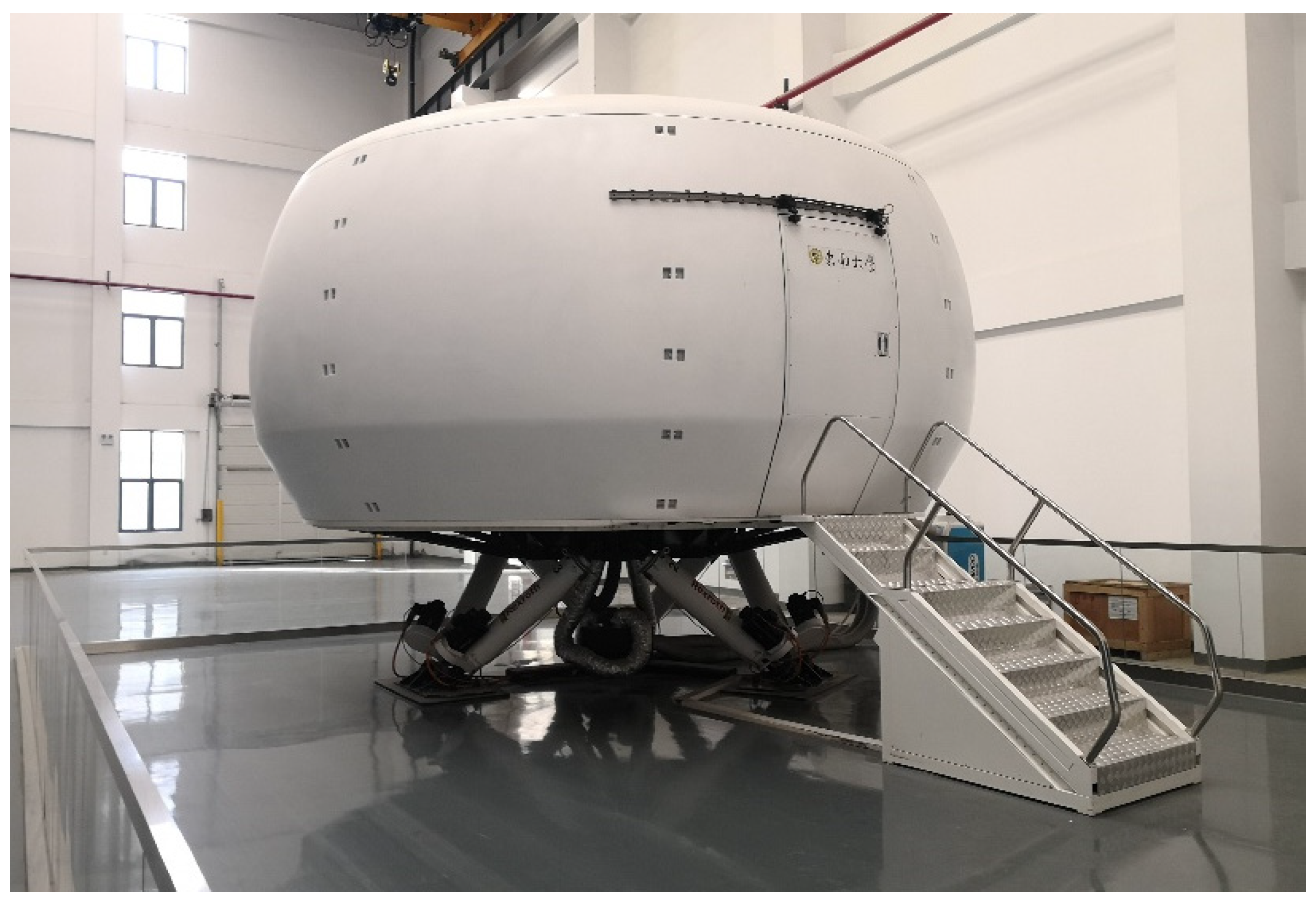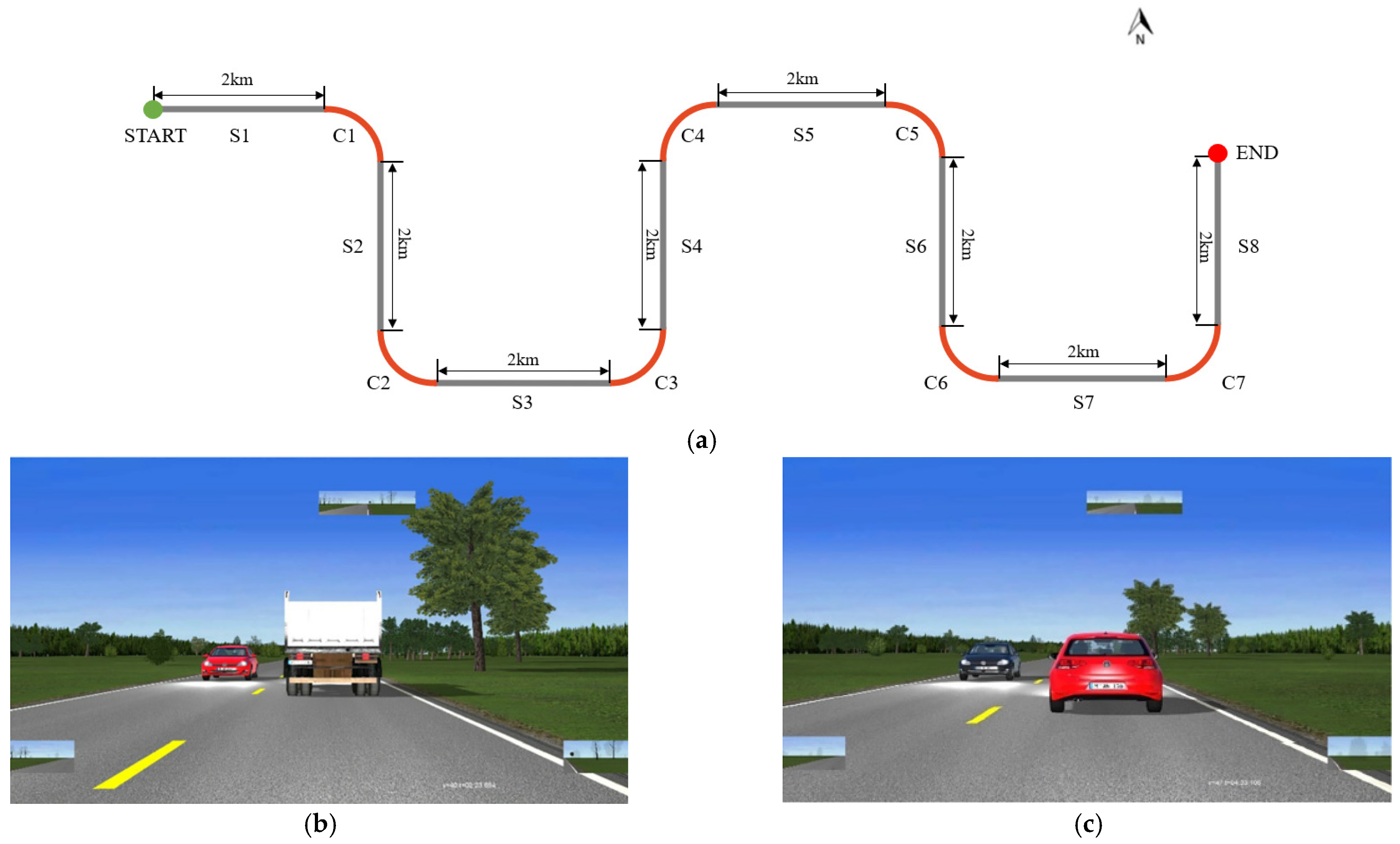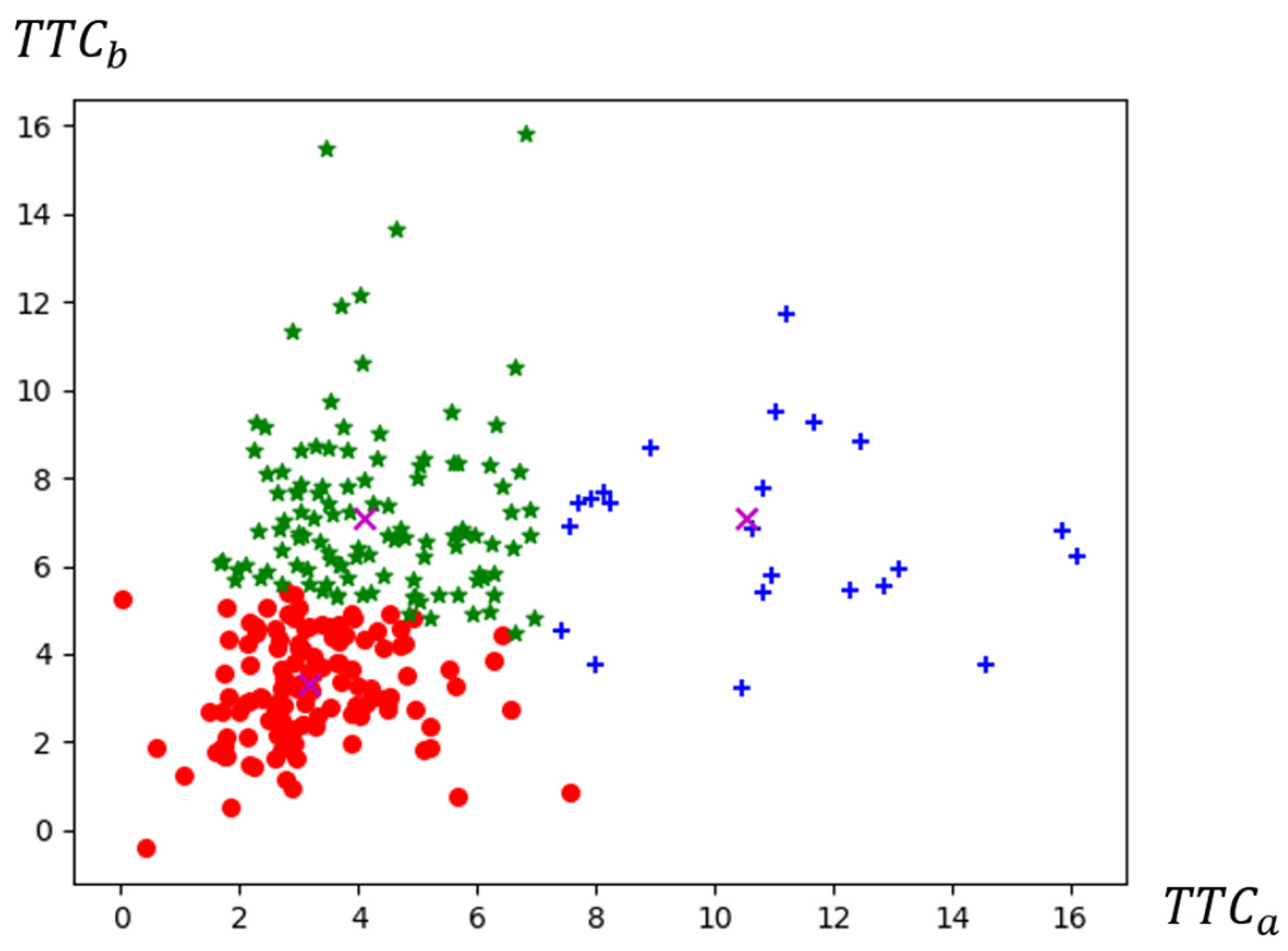Assessing Driving Risk at the Second Phase of Overtaking on Two-Lane Highways for Young Novice Drivers Based on Driving Simulation
Abstract
:1. Introduction
- The lane-changing phase, in which the driver decides to overtake and then changes to the opposite lane.
- The back-to-lane phase, in which the driver returns from the opposite lane to the original lane.
2. Risk Assessment for the Second Phase of Overtaking
2.1. Overtaking Collision Types
2.2. TTC at the Two Critical Positions
2.3. Overtaking Risk Classification Based on Fuzzy C-Means Clustering (FCM)
2.4. Analysis of Influencing Factors
3. The Experiment and Data
3.1. Design of the Experiment
- Vehicle acceleration section: After entering the experimental section, a driver accelerates to his/her habitual speed under the speed limit of the highway, and the section length is set at 200 m.
- Passage section: When a vehicle crosses the white line, an impeding vehicle appears 150 m ahead with a constant speed designed in that scenario, and an opposite vehicle fleet begins to move forward with a constant speed as well. The distance between the vehicles at the opposite lane is 300, 400, and 500 m, respectively, shown in Figure 6. The driver will then choose an appropriate occasion to overtake according to his/her own needs.
3.2. Experimental Process
4. Results
- The first category of the young novice drivers, representing roughly 48% of the total samples in this study, is relatively close to both the impeding and the opposite vehicle when they are turning back to their original lane. The cluster center is 3.167 for and 3.322 for , indicating that this category of drivers does not reserve enough time for their second phase of overtaking, which results in relatively higher collision risk with both the impeding and the opposite vehicle when returning to the original lane. Thus, attention should be paid to this category of drivers, especially regarding their overtaking decision making at the first phase.
- The second category contains the drivers who have a similar value (a cluster center value of 4.111) as the first category, but a relatively larger value (a cluster center value of 7.082), indicating that this category of young novice drivers is quite aware of the approaching vehicle on the opposite lane, but returns to the original lane somewhat in a hurry, thus facing a relatively higher collision risk with the impeding vehicle when they are back to the lane. Such a category represents 43% of the total samples, for which safety concerns are also needed, especially on their TTC perception during the second phase of overtaking.
- Relative to the above two categories, the third category is considered as the safest one in this study. The drivers within this category keep a relatively safer distance with both the impeding and the opposite vehicle when they are driving back to the original lane. The cluster center is 10.535 for and 7.108 for . However, less than 9% of the total samples are within this category, implying that not so many young novice drivers can make accurate judgments when they are at the second phase of overtaking.
- By taking all the samples into account, we can find that about half of them (47.7%) have a low value, while over 90% have a low value. Such a result implies that how to correctly avoid the collision risk with the impeding vehicle when turning back to the original lane is probably a more critical issue for young novice drivers, which should be given a higher priority for intervention.
- Compared with the less risky drivers in the third category, the impeding vehicle speed and the average overtaking speed of the subject vehicle are statistically significant for the other two categories. Generally, a lower speed of the impeding vehicle (30 km/h vs. 50 km/h) tends to result in a lower value of . In other words, young novice drivers are more likely to return early when they find that the speed of the impeding vehicle is low. Similarly, a higher average speed of the subject vehicle normally leads up to a riskier type of turning back (i.e., categories 1 and 2).
- Regarding , which represents the duration between a driver has an intention of overtaking and he/she starts to overtake, it has a statistically significant impact only on the first category of drivers (with both low and values). Such a result helps us to understand that because of the delay in overtaking decision making at the first phase, this type of driver has less time to complete their overtaking maneuver. Thus, a relatively higher collision risk with both the impeding and the opposite vehicle is inevitable when they return to the original lane.
- The speed of the opposite vehicle also has a significant but negative impact on the first category of drivers. It can be explained by the fact that a higher speed of the opposite vehicle (60 km/s vs. 40 km/s) is also one of the possible reasons for this type of driver to have less time to turn back (both and values are low).
- Relative to the drivers in category 3, the impact of the type of the impeding vehicle as well as the passing sight distance on the other two categories is not significant.
5. Discussion
6. Conclusions
- Only very limited young novice drivers (less than 9% of the total samples in this study) can make accurate judgments when they are at the second phase of overtaking.
- Due partly to less driving experience, young novice drivers who hesitate when making an overtaking decision at the first phase (with a larger value of ), usually have a problem of reserving enough time for their second phase of overtaking, thereby frequently resulting in higher collision risk with both the impeding and the opposite vehicle when they are back to the lane (i.e., a lower value of both and ). Around half of the samples (47.7%) belong to this category in our study.
- When turning back to the original lane, the young novice drivers are more likely to be aware of the opposite vehicle that is approaching them, while how to correctly avoid the collision risk with the impeding vehicle at this phase is probably a more critical issue for young novice drivers, representing over 90% of all samples in this study.
- Normally, a higher average speed of the subject vehicle tends to result in a riskier type of turning back. Therefore, speed control is important for young novice drivers when they are conducting an overtaking maneuver, no matter whether at the first phase or the second.
- Regarding the impact of the impeding and the opposite vehicle, in general, young novice drivers tend to return early when they find that the speed of the impeding vehicle is low. Meanwhile, a high speed of the opposite vehicle is more likely to induce risky overtaking maneuvers.
- No significant impact of the type of the impeding vehicle and the passing sight distance on the risk categories is found.
Author Contributions
Funding
Institutional Review Board Statement
Informed Consent Statement
Data Availability Statement
Conflicts of Interest
References
- Lorca, C.; García, A. Evaluation of passing process on two-lane rural highways in Spain with new methodology based on video data. Transp. Res. Rec. J. Transp. Res. Board 2011, 2262, 42–51. [Google Scholar] [CrossRef]
- Oppenheimer, D.M.; Kelso, E. Information processing as a paradigm for decision making. Annu. Rev. Psychol. 2015, 66, 277–294. [Google Scholar] [CrossRef] [PubMed]
- Gordon, D.A.; Mast, T.M. Drivers’ judgments in overtaking and passing. Hum. Factors 1970, 12, 341–346. [Google Scholar] [CrossRef]
- Gray, R.; Regan, D.M. Risky driving behavior: A consequence of motion adaptation for visually guided motor action. J. Exp. Psychol. Hum. Percept. Perform. 2000, 26, 1721. [Google Scholar] [CrossRef]
- Gray, R.; Regan, D.M. Perceptual processes used by drivers during overtaking in a driving simulator. Hum. Factors 2005, 47, 394–417. [Google Scholar] [CrossRef] [PubMed]
- Lev, D.; Hershkovitz, E.; Yechiam, E. Decision making and personality in traffic offenders: A study of Israeli drivers. Accid. Anal. Prev. 2008, 40, 223–230. [Google Scholar] [CrossRef]
- Zheng, Y.; Ran, B.; Qu, X.; Zhang, J.; Lin, Y. Cooperative lane changing strategies to improve traffic operation and safety nearby freeway off-ramps in a connected and automated vehicles environment. IEEE Trans. Intell. Transp. Syst. 2020, 21, 4605–4614. [Google Scholar] [CrossRef]
- Li, M.; Li, Z.; Xu, C.; Liu, T. Short-term prediction of safety and operation impacts of lane changes in oscillations with empirical vehicle trajectories. Accid. Anal. Prev. 2020, 135, 105345. [Google Scholar] [CrossRef]
- Bar-Gera, H.; Shinar, D. The tendency of drivers to pass other vehicles. Transp. Res. Part F Traffic Psychol. Behav. 2005, 8, 429–439. [Google Scholar] [CrossRef]
- Mohaymany, A.; Kashani, A.; Ranjbari, A. Identifying driver characteristics influencing overtaking crashes. Traffic Inj. Prev. 2010, 4, 411–416. [Google Scholar] [CrossRef]
- Fabio, L.; Giannini, A.M.; Sgalla, R.; Mallia, L.; Devoto, A.; Reichmann, S. Young novice driver subtypes: Relationship to driving violations, errors and lapses. Accid. Anal. Prev. 2010, 42, 1689–1696. [Google Scholar]
- Gabriela, R.; Poulter, D.; Barker, E.; McKenna, F.P.; Rowe, R. Novice drivers’ individual trajectories of driver behavior over the first three years of driving. Accid. Anal. Prev. 2015, 82, 61–69. [Google Scholar]
- Gresham, B.; Mcmanus, B.; Mrug, S.; Visscher, K.; Anthony, T.; Stavrinos, D. Validation of the attention-related driving errors scale in novice adolescent drivers. Accid. Anal. Prev. 2021, 159, 106249. [Google Scholar] [CrossRef] [PubMed]
- Wilson, T.; Best, W. Driving strategies in overtaking. Accid. Anal. Prev. 1982, 14, 179–185. [Google Scholar] [CrossRef]
- Bai, W.; Li, C.J. Overtaking Model Based on Different Limiting Speed. J. Transp. Syst. Eng. Inf. Technol. 2013, 13, 2. [Google Scholar]
- Chandra, S.; Shukla, S. Overtaking behavior on divided highways under mixed traffic conditions. Procedia-Soc. Behav. Sci. 2012, 43, 313–322. [Google Scholar] [CrossRef] [Green Version]
- Vlahogianni, E.I. Modeling duration of overtaking in two-lane highways. Transp. Res. Part F Traffic Psychol. Behav. 2013, 20, 135–146. [Google Scholar] [CrossRef]
- Asaithambi, G.; Shravani, G. Overtaking behaviour of vehicles on undivided roads in non-lane based mixed traffic conditions. J. Traffic Transp. Eng. 2017, 3, 44–53. [Google Scholar] [CrossRef]
- Rahul, S.; Vasudevan, V.; Dutta, B. Analysis of overtaking patterns of indian drivers with data collected using a lidar. Transp. Res. Part F Traffic Psychol. Behav. 2020, 74, 139–150. [Google Scholar]
- Llorca, C.; García, A.; Moreno, A.T.; Pé rez-Zuriaga, A.M. Influence of age, gender and delay on overtaking dynamics. IET Intell. Transp. Syst. 2013, 7, 174–181. [Google Scholar] [CrossRef]
- Jenkins, J.M.; Rilett, L.R. Classifying passing maneuvers—A behavioral approach. Transp. Res. Rec. J. Transp. Res. Board 2005, 1937, 14–21. [Google Scholar] [CrossRef]
- Farah, H.; Bekhor, S.; Polus, A.; Toledo, T. A passing gap acceptance model for two-lane rural highways. Transportmetrica 2009, 5, 159–172. [Google Scholar] [CrossRef]
- Llorca, C.; Farah, H. Passing behavior on two-lane roads in real and simulated environments. Transp. Res. Rec. J. Transp. Res. Board 2017, 2556, 29–38. [Google Scholar] [CrossRef] [Green Version]
- Figueira, A.C.; Larocca, A. Analysis of the factors influencing overtaking in two-lane highways: A driving simulator study. Transp. Res. Part F Traffic Psychol. Behav. 2020, 69, 38–48. [Google Scholar] [CrossRef]
- Underwood, G.; Crundall, D.; Chapman, P. Driving simulator validation with hazard perception. Transp. Res. Part F Traffic Psychol. Behav. 2011, 14, 435–446. [Google Scholar] [CrossRef]
- Llorca, C.; García, A.; Perez, A.; Moreno, A.T. New experimental approach for passing gap acceptance. J. Transp. Res. Board 2012, 2012, 11–18. [Google Scholar]
- Toledo, T.; Farah, H. Alternative definitions of passing critical gaps. Transp. Res. Rec. J. Transp. Res. Board 2011, 2260, 76–82. [Google Scholar] [CrossRef]
- Farah, H.; Bekhor, S.; Polus, A. Risk evaluation by modeling of passing behaviour on two-lane rural highways. Accid. Anal. Prev. 2009, 41, 887–894. [Google Scholar] [CrossRef]
- Mocsari, T. Analysis of overtaking behavior of motor vehicle drivers. Acta Tech. Jaurinensis 2009, 1, 97–106. [Google Scholar]
- Farah, H. Age and gender differences in overtaking maneuvers on two-lane rural highways. Transp. Res. Rec. J. Transp. Res. Board 2011, 2248, 30–36. [Google Scholar] [CrossRef]
- Shinar, D. Traffic Safety and Human Behavior; Emerald Publishing Limited: Bingley, UK, 2017. [Google Scholar] [CrossRef]
- Guo, Y.; Sayed, T.; Essa, M. Real-time conflict-based Bayesian Tobit models for safety evaluation of signalized intersections. Accid. Anal. Prev. 2020, 144, 105660. [Google Scholar] [CrossRef] [PubMed]
- Wang, C.; Xie, Y.; Huang, H.; Liu, P. A review of surrogate safety measures and their applications in connected and automated vehicles safety modeling. Accid. Anal. Prev. 2021, 157, 106157. [Google Scholar] [CrossRef] [PubMed]







| Impeding Vehicle Speed (IVS) | |||||||
| 30 km/h | 50 km/h | ||||||
| Impeding vehicle type | Impeding vehicle type | ||||||
| Car (PC) | Truck (TR) | Car (PC) | Truck (TR) | ||||
| Opposite vehicle speed | Opposite vehicle speed | Opposite vehicle speed | Opposite vehicle speed | ||||
| 40 km/h | 60 km/h | 40 km/h | 60 km/h | 40 km/h | 60 km/h | 40 km/h | 60 km/h |
| 30-PC-40 | 30-PC-60 | 30-TR-40 | 30-TR-60 | 50-PC-40 | 50-PC-60 | 50-TR-40 | 50-TR-60 |
| 1 | 2 | 3 | 4 | 5 | 6 | 7 | 8 |
| Variable | Description |
|---|---|
| Coordinates of the subject vehicle (m) | |
| Speed of the subject vehicle (m/s) | |
| Steering angle of the subject vehicle (rad) | |
| Coordinates of the impeding vehicle (m) | |
| Speed of the impeding vehicle (m/s) | |
| Coordinates of the opposite vehicle (m) | |
| Speed of the opposite vehicle (m/s) | |
| The average speed of the subject vehicle when completing an overtaking (m/s) | |
| The duration when the driver has the idea of overtaking until he starts to overtake (s) (determined from turn signals and specific steering angle) | |
| t | Time (s) |
| PSD | Passing sight distance (m) |
| Cluster Category | Two-Dimensional Risk Index | Number of Samples | Proportion | |
|---|---|---|---|---|
| 1 | 3.167 (M = 3.231, SD = 1.257) | 3.322 (M = 3.228, SD = 1.239) | 125 | 47.7% |
| 2 | 4.111 (M = 4.269, SD = 1.408) | 7.082 (M = 7.152, SD = 2.119) | 113 | 43.1% |
| 3 | 10.535 (M = 10.599, SD = 2.707) | 7.108 (M = 6.472, SD = 2.456) | 23 | 8.8% |
| Factors | B | Standard Error | Wald | Significance | Exp (B) | |
|---|---|---|---|---|---|---|
| 1 | 0.675 | 0.178 | 14.287 | 0.000 | 1.963 | |
| 0.133 | 0.064 | 4.316 | 0.038 | 1.143 | ||
| [type = 0] | 0.760 | 0.591 | 1.649 | 0.199 | 2.137 | |
| = 30] | 3.364 | 1.279 | 6.915 | 0.009 | 28.918 | |
| = 40] | −1.232 | 0.613 | 4.036 | 0.045 | 0.292 | |
| [PSD = 1] | 2.123 | 2.170 | 0.957 | 0.328 | 8.354 | |
| [PSD = 2] | 2.096 | 1.885 | 1.235 | 0.266 | 8.130 | |
| [PSD = 3] | 0.490 | 1.866 | 0.069 | 0.793 | 1.632 | |
| 2 | 0.560 | 0.167 | 11.300 | 0.001 | 1.751 | |
| 0.072 | 0.059 | 1.513 | 0.219 | 1.075 | ||
| [type = 0] | 0.492 | 0.561 | 0.770 | 0.380 | 1.635 | |
| = 30] | 3.846 | 1.276 | 9.090 | 0.003 | 46.789 | |
| = 40] | −0.173 | 0.574 | 0.091 | 0.763 | 0.841 | |
| [PSD = 1] | −3.246 | 1.971 | 2.711 | 0.100 | 0.039 | |
| [PSD = 2] | −0.806 | 1.608 | 0.251 | 0.616 | 0.447 | |
| [PSD = 3] | −1.254 | 1.563 | 0.644 | 0.422 | 0.285 |
Publisher’s Note: MDPI stays neutral with regard to jurisdictional claims in published maps and institutional affiliations. |
© 2022 by the authors. Licensee MDPI, Basel, Switzerland. This article is an open access article distributed under the terms and conditions of the Creative Commons Attribution (CC BY) license (https://creativecommons.org/licenses/by/4.0/).
Share and Cite
Pan, J.; Shen, Y. Assessing Driving Risk at the Second Phase of Overtaking on Two-Lane Highways for Young Novice Drivers Based on Driving Simulation. Int. J. Environ. Res. Public Health 2022, 19, 2691. https://doi.org/10.3390/ijerph19052691
Pan J, Shen Y. Assessing Driving Risk at the Second Phase of Overtaking on Two-Lane Highways for Young Novice Drivers Based on Driving Simulation. International Journal of Environmental Research and Public Health. 2022; 19(5):2691. https://doi.org/10.3390/ijerph19052691
Chicago/Turabian StylePan, Jie, and Yongjun Shen. 2022. "Assessing Driving Risk at the Second Phase of Overtaking on Two-Lane Highways for Young Novice Drivers Based on Driving Simulation" International Journal of Environmental Research and Public Health 19, no. 5: 2691. https://doi.org/10.3390/ijerph19052691
APA StylePan, J., & Shen, Y. (2022). Assessing Driving Risk at the Second Phase of Overtaking on Two-Lane Highways for Young Novice Drivers Based on Driving Simulation. International Journal of Environmental Research and Public Health, 19(5), 2691. https://doi.org/10.3390/ijerph19052691






